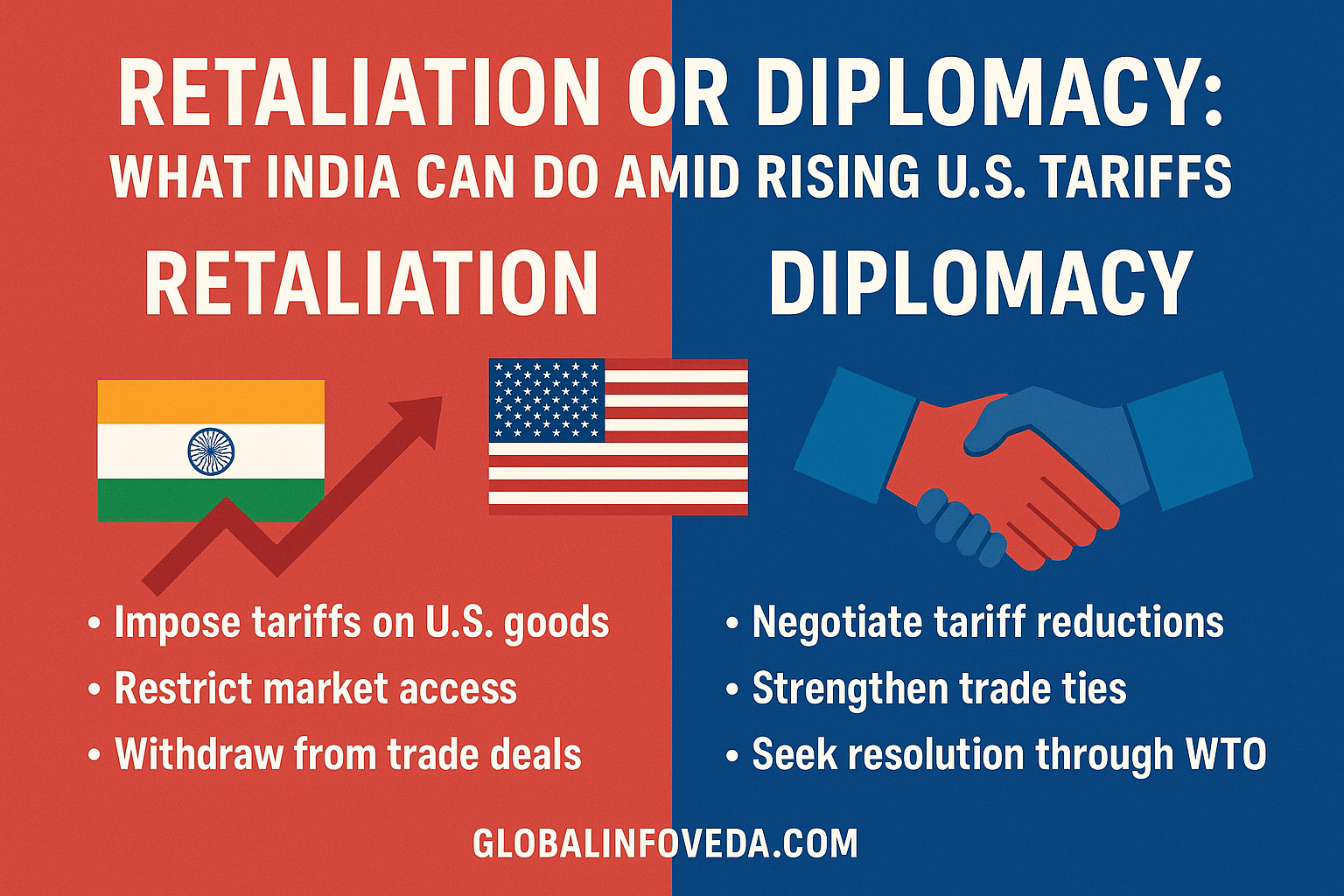What India Can Do Amid Rising U.S. Tariffs
🌍 Introduction: Navigating the Tariff Storm
As the United States intensifies its protectionist trade measures, India faces a crucial decision fork: respond with countermeasures or double down on diplomatic engagement. With Indian exports across pharma, steel, IT, textiles, and automotive components taking a hit due to high U.S. tariffs ranging from 10% to 40%, the government must weigh each step not just from an economic angle—but in light of its long-term geopolitical alignment, global market access, and supply chain dependencies.
This blog explores the strategic response matrix available to India in 2025—from tactical retaliations and institutional diplomacy to broader efforts at trade diversification and technological sovereignty.
🚨 Immediate Impact of Tariffs: What’s at Stake
- $89 billion in Indian annual exports to the U.S. are now exposed to trade barriers.
- Textile and garment clusters in Ludhiana, Surat, and Tiruppur face mass layoffs.
- Pharma contract manufacturers in Baddi, Vizag, and Hyderabad report order cancellations.
- IT service exports see delay in payments and reduced contract sizes.
- Steel and engineering goods from Odisha, Maharashtra, and Gujarat are re-routed.
- INR volatility spikes, hitting ₹86–₹87/USD levels as trade deficit concerns grow.
The effects are being felt disproportionately across India’s MSME base and Tier-2 industrial clusters that heavily rely on U.S. contracts.
Additionally:
- Trade finance cycles are tightening, with exporters reporting delayed remittances.
- Foreign portfolio investors (FPIs) have started pulling funds from India’s export-heavy indices.
- Container freight rates have risen by 12% YoY, reflecting global supply chain risk.
🤝 Diplomatic Tools: Engagement Over Escalation
India has four high-leverage diplomatic avenues:
1. WTO Dispute Mechanism:
- India can formally file a trade violation complaint under WTO.
- Past wins include solar panel subsidies and poultry import bans.
- It serves to internationalize the issue while allowing time for backdoor diplomacy.
- Joint filing with other Global South nations adds pressure.
2. Bilateral Mini-Deals:
- India could propose a sector-specific tariff freeze for pharma, agri-tech, and semiconductors.
- Push for revival of the India-U.S. Trade Policy Forum.
- Restructure digital trade tax clauses to find mutual ground.
- Offer to co-invest in U.S. semicon supply chains to align incentives.
3. Regional and Multilateral Leverage:
- Use Quad, BRICS, IPEF, and G20 to highlight impact on Global South.
- Position India as a bridge player between West and Global South.
- Host a Global Tariff Dialogue Summit inviting both adversarial and neutral players.
4. Geo-Economic Lobbying:
- Activate India’s tech, pharma, and business diaspora in the U.S. to influence legislators.
- Approach U.S. importers, tech giants, and healthcare providers reliant on Indian inputs.
- Leverage the India Caucus in U.S. Congress and business advocacy groups like USIBC.
⚖️ Strategic Retaliation Options: Balancing the Scales
India can opt for graduated, industry-specific responses:
1. Smart Counter-Tariffs:
- Apply mirror tariffs on niche U.S. exports like Harley-Davidson bikes, Californian wine, and almonds.
- Announce these as temporary balancing tariffs, subject to review.
2. Procurement Diversion:
- Update public procurement policy to favor non-U.S. sources for defense, telecom, infrastructure.
- Award large PSU contracts to European or Asian consortiums.
3. Digital Policy Leverage:
- Enforce mandatory local data storage and audit trails for U.S. digital firms.
- Launch SwarajyaStack 2.0 and incentivize state governments to adopt.
- Reassess ad revenue taxation and payment gateway licenses of U.S. firms.
4. FTA Acceleration:
- Fast-track FTAs with EU, EFTA (Switzerland, Norway), Australia, South Korea, and Africa.
- Include digital goods, fintech, and green tech provisions in FTA drafts.
- Operationalize INR-dirham, INR-baht, and INR-peso corridors.
5. Strategic Public Messaging:
- Use global platforms to position India as a defender of trade fairness.
- Frame actions as pro-sovereignty and pro-stability, not isolationist.
- Communicate India’s openness to negotiation while defending its development space.
🌐 Long-Term Strategy: Self-Reliance and Strategic Hedging
To reduce long-term tariff risk exposure:
- PLI Expansion 3.0: Introduce new incentives for biosimilars, technical textiles, drone systems, and quantum chips.
- Chabahar & INSTC Revamp: Make Middle Eastern and Central Asian corridors viable for India-Eurasia trade.
- ECGC Boost: Scale export credit guarantees to cover U.S. and EU exposure.
- Export Market Missions: Open 25 new trade missions in Central Asia, Africa, and Latin America.
- Customs Modernization Drive: Digitize customs-to-port workflows to reduce friction for non-U.S. exports.
- Value Chain Upgradation: Fund R&D clusters in bio-pharma, clean-tech, and agri-automation.
- Skill India for Export 2.0: Train 10 lakh workers in export-ready sectors including AI and carbon-neutral manufacturing.
India must treat the 2025 trade rift as a launchpad for systemic transformation.
🧭 Final Insight: Assertive Yet Measured
India’s optimal response lies in three simultaneous fronts:
- Tactical diplomacy, leveraging every institutional and informal backchannel.
- Smart retaliation, targeted to influence without triggering escalation.
- Long-term hedging, rebuilding a globally diversified, innovation-driven export model.
As the U.S. election cycle intensifies tariff rhetoric, India must stay above the fray—strong but not reactive, strategic but not submissive.
📡 For expert perspectives and India’s next policy moves, follow GlobalInfoVeda.com
